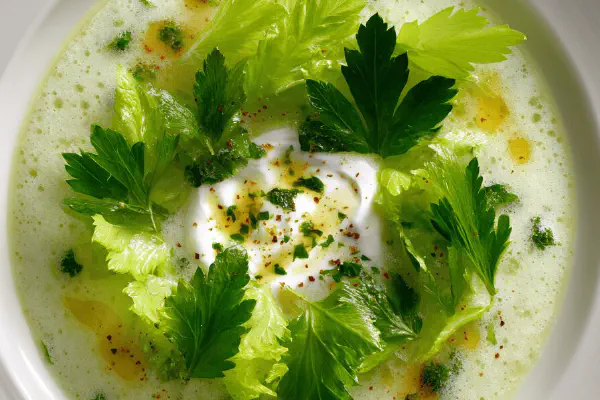Chilled Celery Soup

By Emma
Certified Culinary Professional
Ingredients
- 1.2 litres celery stalks cut into chunks
- 1 small leek finely sliced
- 1 garlic clove minced
- 25 ml unsalted butter
- 700 ml vegetable or chicken stock
- 400 ml water
- 1 medium parsnip peeled diced
- 2.5 ml celery salt
- Ice cubes
- 120 ml crème fraîche
- Celery seeds and fresh celery leaves to garnish
- Salt and pepper to taste
About the ingredients
Method
- Start by melting butter over medium heat in a large pan.
- Add celery pieces leek and garlic. Stir often until veggies soften and start releasing aroma about 8–10 minutes.
- Pour in stock water add parsnip and celery salt. Bring to gentle boil bubbles rising around edges.
- Simmer uncovered around 25 minutes. Test tenderness by poking parsnip or celery with fork should slide without resistance.
- Remove from heat let cool slightly then puree in blender until fully smooth no chunks left.
- For silkiness push mixture through fine sieve pressing with spoon or spatula.
- Chill soup minimum 3 hours preferably 4 in fridge to develop flavors and thicken slightly.
- Before serving adjust thickness adding cold stock or water if too stiff.
- Season with salt pepper carefully celery salt adds salty but don’t overdo.
- Serve in bowls add one ice cube and dollop crème fraîche on top.
- Sprinkle celery seeds whole and tuck in fresh celery leaves for texture and a little bitterness.
- Variation swap parsnip for peeled celeriac for earthier tone or fennel bulb for aromatic twist.
- If no crème fraîche, lightly whipped cream or plain yogurt works but keep chill for freshness.
Cooking tips
Chef's notes
- 💡 Butter melts slow medium heat. Don’t rush browning. Sizzle gentle, veggies soften softness counts more than color. Leek translucent that’s good. Garlic last addition avoid biting bitterness burning. Parsnip diced same size as celery chunks keeps cook times even, test fork before proceeding.
- 💡 Simmer open pan. Watch bubbles edges not roaring boil. Stir occasionally quiet simmer keeps aroma fresh without hardness or breakdown. Parsnip firmness guide timing. When fork presses through easily, stop cooking immediately. Longer turns mushy, ruins texture purity after blending.
- 💡 Blender until no chunks. Run over sieve next. Skipping sieve means grit or strings. Spoon presses slow. Patience. Skipping results textural compromise. Silky means no bits. Chill uncovered or loose cover to avoid soggy condensation float on surface. Cool time critical to flavor marry and texture thicken naturally.
- 💡 Ice cube in serving bowl melts slow. Controls dilution gently adds meltwater chill in mouth. Add crème fraîche on top not stirred in. Temperature contrast hits differently on palate. Garnish last minute celery leaves fresh, crisp, slight bitterness contrast with creamy dollop. Celery seeds optional sparing crunch not overpower.
- 💡 Substitutions common. No parsnip? Use peeled celeriac but simmer longer tougher root. Fennel bulb switch adds aromatic layer needing less celery salt. Butter swap olive oil reduces dairy but watch slick greasy feel. Stock homemade preferred; store-bought often too salty overwhelms celery’s subtlety. Crème fraîche can be Greek yogurt whisked gently to avoid curdle but chill well before serving.
Common questions
How to tell when vegetables are done?
Fork test best. Parsnip and celery soften but still hold shape. Visual cues too—bubbles gentle edges, no aggressive boil. Aroma changes too—veggies smell sweeter and mellow without sharp raw garlic. Texture less fibrous. Timing isn’t fixed timing but sensory driven.
Can I skip sieving puree?
You can but expect rougher mouthfeel. No sieve means strings or tiny bits remain. Pressure needed to press through sieve worth extra effort for silkiness. Some tolerate texture variation. Depends on preference. Sometimes rush forces skipping but flavor suffers.
What if soup too thick after chilling?
Add cold stock or water incrementally. Adjust slowly. Adding warmed liquid ruins chill and texture. Taste after each addition. Celery salt potent add lightly after thinning. Over dilute ruins flavor balance. Ice cube helps melt slow dilution in bowl too.
How to store leftovers?
Refrigerate covered or lightly covered. Avoid airtight trap moisture condensation causes surface sogginess. Can freeze but texture changes after thawing, separate freeze best. Reheat gently low heat avoid breaking dairy, skim if separation occurs. Consume within 2-3 days fridge for freshness.



